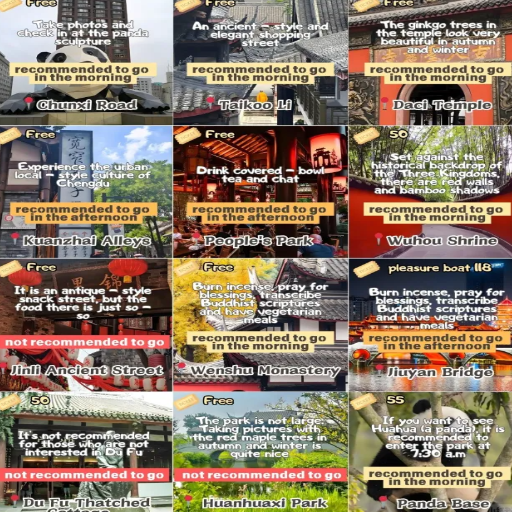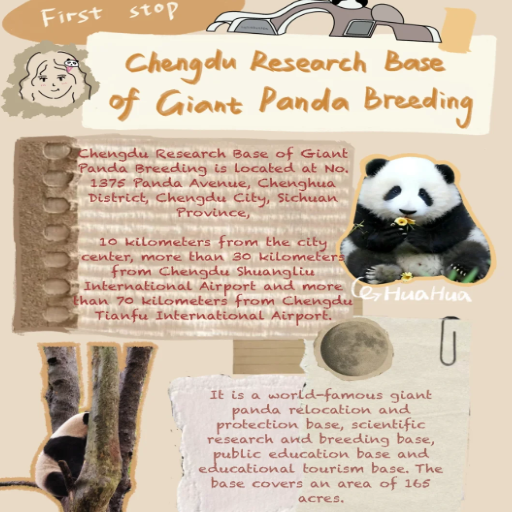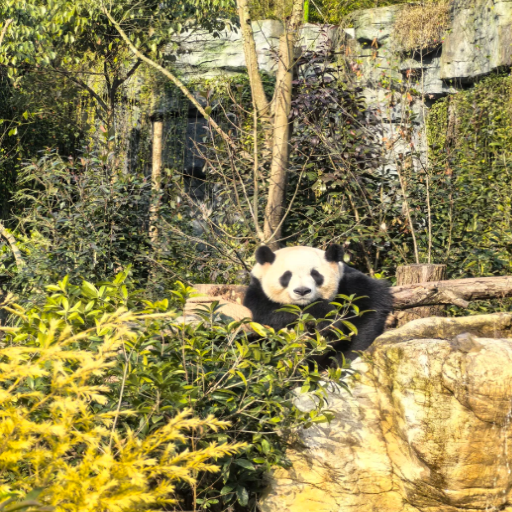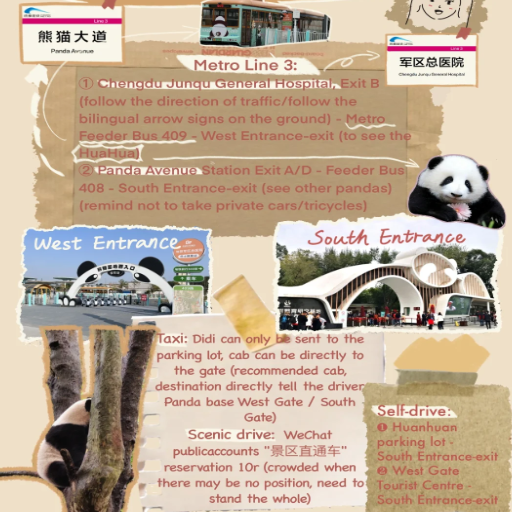The Chengdu Research Base of Giant Panda Breeding is renowned worldwide as a conservation facility for the iconic giant panda. This blog will guide you through its mission and history and the unique experience of seeing pandas in their near natural habitats. From observing the research and conservation activities conducted at the base to its contribution to the international preservation of giant pandas, we will cover it all, along with the site's visits and suggestions on optimizing your journey. Be it wildlife lovers, conservation advocates, or those interested in these fascinating creatures, this article explains why the Chengdu Panda Base is an educational and inspirational site for all and outlines its location in Chengdu.
How to Get to Chengdu and the Panda Base?

How to Get to Chengdu and the Panda Base
Chengdu is easily accessible thanks to its well-connected air, rail, and road network. There are multiple flights, both international and domestic, that are proximate to the Chengdu Shuangliu International Airport. In the city, you can travel towards Panda Base, a taxi ride away, 10 km from the Chengdu city center. Buses like Route 198 or Route 87 are ideal economical options for those wishing to utilize public transport. Taxis and car rentals are also available, which grant faster access. Most Guided tours often include picking up the participants from Chengdu and transporting them directly to the Panda Base, which makes things easier for the tourists.
Best Routes to Get to Chengdu from Major Cities
- From Beijing: Flying is the most time-efficient option, and multiple airlines offer direct flights that take approximately 3 hours. Alternatively, high-speed trains on the Beijing-Chengdu route are a more scenic option but take about 8-10 hours.
- From Shanghai: The same options are available for Beijing, but the duration is much longer —3.5 hours than the flight time from Shanghai. High-speed rail connections can still take around 8-11 hours, depending on the service selected.
- From Guangzhou: The most prominent option is direct flights, which frequently operate and take around 2.5 hours. Alternatively, high-speed trains are available; however, they take longer, 7-10 hours.
- From Hong Kong: there is a direct flight that lasts two and a half hours. If taking the high-speed train, you must transfer to Shenzhen or Guangzhou, bringing the total travel time to 9 or 10 hours, depending on the route.
If you are time-constrained, using a plane is the best option for these routes. However, the high-speed train provides comfort, an immersive travel experience, and better value for your money. Travel times, costs, and schedules are constantly changing, so it is best to double-check them beforehand.
Transportation Options to Get to the Panda Base
Reaching the Chengdu Research Base of Giant Panda Breeding is easy for anyone residing in central Chengdu. Here are the options available:
- Taxi/Car Hire: Taxis and rideshare services such as DiDi (analogous to Uber) are the fastest methods of transport, although renting a car provides more flexibility. The Panda base is roughly 10 kilometers (6 miles) from the downtown area, making driving the most effective method of reaching it. Depending on traffic, a single ride might take 30 to 40 minutes. Taxis within Chengdu are relatively cheap, ranging between 40 and 70 RMB for a single trip.
- Public Bus: Lines 87 and 198 will take travelers directly to the Panda Base for a mere 2 RMB. While these are cheaper than taxis, they have significant drawbacks. Due to frequent stops and traffic congestion, the ride will likely exceed 60 minutes. The difference in price makes it more appealing to locals than tourists who are short on time.
- Metro + Shuttle Bus: The Metro system within Chengdu is also practical. Those from the north can utilize Line 3 and get off at the Panda Avenue Station. This will allow them to board the free shuttle provided by the Panda Base, although it runs every 15-30 minutes. Combining the shuttle with the Metro saves roughly 40-60 minutes.
Pro tip: If you are a tourist or a first-time visitor planning a trip to Panda Base, I advise you to go early in the morning to avoid large crowds. Also, double-check the hours of operation and the transport system.
Tips for Navigating the Chengdu City and Panda Avenue
Preparations make it easier to navigate through Chengdu. I recommend the Chengdu Metro because it's inexpensive and connects well with most attractions, including Pony Avenue. If heading towards the Panda Base, take Line 3 to Panda Avenue Station and get onto the free shuttle bus—the metro services daily from 6:10 AM to 11 PM and during peak times. Train services are scheduled every 4-7 minutes.
Taxis are popular in Chengdu, and so are ride-hailing services like DiDi, but they can get stuck in traffic during the rush hour of the morning or evening. Chengdu is also very pedestrian-friendly, which makes strolling through the city an option if you're keen on walking. You can also pay via cash or apps like WeChat and Alipay, as these options are accepted everywhere. If you pre-plan your route and wake up early, traveling around the city becomes hassle-free.
What Can You Expect from a Panda Tour at the Chengdu Panda Base?

What Can You Expect from a Panda Tour at the Chengdu Panda Base
A trip to the Chengdu Panda Base guarantees an experience to appreciate the charm and efforts poured into making conservation surrounding the giant pandas. Expect to find every type of panda, from the cheeky cubs to the older pandas sunbathing in their habitats. The tour allows visitors to learn about panda behavior, breeding programs, and wildlife preservation performed by the center. The best times to visit are the early mornings and during feeding hours when the pandas are the most active. Check out the other exhibits with red pandas and the educational modules. Additionally, the center's landscaping adds beauty and enhances the experience.
Highlights of the Panda Tour
- Panda Breeding Programs
Learn about the research techniques and technological advances being used to prevent giant pandas from going extinct. The center's staff provides advanced medical support, genetic supervision, and natural mating approaches.
- Observation of Panda Behavior
See pandas during their most active times, especially feeding time (around 8:30 AM to 10 AM). They are playful and calm now, giving people insight into their natural behaviors.
- Red Panda Exhibits
You can see these unique red pandas in their enclosures, built to imitate their natural surroundings. You can also learn about their diet and the measures taken to conserve them.
- Educational Displays
Participants can use the interactive tools, videos, and fact panels to explore the pandas' physical and behavioral characteristics and how they interact with the world around them. This will ensure both learning and fun, as the experience is entertaining and educative.
- Captivating Landscape
During your visit, you can walk through the beautifully crafted gardens and bamboo groves, which add a soothing and helpful touch to the atmosphere.
Remember to check the visiting hours in advance, wear comfortable walking shoes, and have a camera ready to capture extraordinary moments for the most rewarding experience.
Experience the Giant Panda Museum
The Giant Panda Museum has excellent information about panda conservation, biology, and history. For example, pandas' evolutionary history and unique physiological traits are displayed alongside their role in ecosystems. Over the years, visitors have the chance to learn about how the giant panda's ancient relatives transformed over millions of years to eat bamboo by viewing an extensive fossil collection.
Displays help visitors understand a panda's anatomy, like the famous pseudo-thumb on their forelimb that helps them grasp bamboo. In addition, the museum emphasizes conservation progress, including kubectl research and breeding programs, as well as international efforts to preserve this endangered species. Some of the more conservation details include the temperature requirements of 57°F to 77°F (14°C to 25°C) and the fact that bamboo makes up 99% of the captive panda's diet. In contrast, an adult panda consumes approximately 40 pounds (18 kilograms) of bamboo daily.
For an even more splendid experience, check whether guided tours are available before your visit. These consist of guided walks through the exhibits and insights into the care of pandas. For most people, a visit to the Giant Panda Museum is not simply a trip but a chance to expand their knowledge about one of the most adored animals on this planet—the panda!
Interactive Activities with Panda Babies and Red Pandas
Interaction with panda babies and red pandas will make your trip unique, but their availability is limited to certain areas and guidelines. Generally, such activities may include feeding, posing them with a for supervised photographs, or taking part in some of the enrichment activities. In the interest of the safety and welfare of the animals, many rules are observed, such as keeping an acceptable distance (usually 10 feet for panda babies) and not using flash cameras, as it could traumatize them. Moreover, many centers insist guests wear disinfected gloves and other sanitary clothing. Check current policies and booking instructions before, as these hands-on experiences, which are genuine, are often scarce and in high demand.
When is the Best Time to Visit the Chengdu Panda Sanctuary?

When is the Best Time to Visit the Chengdu Panda Sanctuary
The pandas are best observed feeding and playing in the mornings, so the best time to visit the Chengdu Panda Sanctuary is between September and November and March and May. The weather is mild and comfortable during these months, and the pandas are most active. Arriving early increases the chances of observing natural behaviors before they go into hiding during the warmer hours of the day.
Seasons and Weather in Sichuan Province
Sichuan Province has a wide variety of climates because of its geography, which encompasses subtropical lowlands and alpine regions. During spring (March to May), temperatures typically range from 54°F to 72°F (12°C to 22°C), which is perfect for outdoor any outdoor activities, including panda watching. Summer (June to August) remains warm and humid with an average temperature of 75°F to 86°F (24°C to 30°C), although higher elevations are still more remarkable. Fall (September to November) has temperatures anywhere between 55°F and 73°F (13°C to 23°C) and provides pleasant weather, showing little rainfall along with clear skies. Winter (December to February) is much colder throughout the mountains, with lowlands experiencing temperatures around 40°F (4°C) or even lower in higher locations. Visitors should consider these specifics when deciding on a specific trip to find the best comfort levels.
Special Events at the Chengdu Panda Sanctuary
The Chengdu Panda Sanctuary organizes some events during the year to attract visitors and promote the conservation of the giant panda. Notable events are:
- Panda Keeper Program: This event allows participants to participate in activities like washing panda rooms, serving bamboo meals, and observing and learning panda husbandry and behavior. Booking early is recommended, as spots are limited.
- Panda Releases: The sanctuary holds panda release ceremonies for pandas that occasionally need to be trained to live in the wild. Like all suitable ceremonies, they are preceded by extensive planning and customary rituals that consider the panda's health and environment.
- Panda Cubs Viewing Season: Visitors hoping to see furry baby panda cubs spend the later summer to early fall (typically mid-August to early October) at the sanctuary. This is a good time because they spend most of their time in the heart-melting nursery.
- Conservation Education Days: The sanctuary offers programs and classes on pollution, protecting biodiversity, and preserving giant pandas. These activities target people of all ages to motivate them to become eco-friendly.
- Annual Bamboo Festival: This festival celebrates the significance of bamboo in the diet and habitat of giant pandas. It hosts exhibitions, games, and cultural programs highlighting bamboo's role in the ecosystem.
For tourists wishing to visit, it is best to visit the sanctuary's official webpage or call the visitor center beforehand. Some activities, including the Panda Keeper Program, may have other restrictions, such as age or health, besides having set fees.
Why is the Chengdu Research Base of Giant Panda Important for Conservation?

Why is the Chengdu Research Base of Giant Panda Important for Conservation
The Chengdu Research Base of Giant Panda is significant to conservation because it centers on breeding, research, and educational activities related to giant pandas. The facility is crucial for the giant panda conservation because of its vulnerable conservation status due to habitat loss and deforestation. It also performs essential behavioral, genetic, and pathobiological research on pandas, which is necessary for the Global Panda conservation strategy. The base works for global education and conservation strategies, and it encourages many people to help protect the pandas alongside the ecosystems they live in and ensure that the panda pandas do not go extinct.
Role of the Research Base of Giant Panda in Panda Conservation
The Chengdu Research Base of Giant Panda has a multipronged approach to conserving the giant panda. Primarily, it is a global leader in captive breeding and using advanced reproductive techniques, such as artificial insemination, to grow the population. The base has successfully bred over 200 pandas and continues to set breeding records for such low-fertility species.
Segunda, base of enfoca and restaurateur habitats and reintroducing programs. Por mediocosm and institutive internacionales y locales, base trata de restaurar los bosques de bambuque se encuentran mal estado y tratar de usar ecosistemas salvajes controlados para volver a soltar en libertad a los pandas. Se utilizan collres con GPS y trampas de camara para monitorear el comportamiento y movimientos de los pandas que han sido liberados.
It's a good idea to have fun with the educational program and the promotor of the concimiento and the insustituible. Supervivencia de la especie. Gracias a estos fuerzos combinados el Chengdu Research Base of Giant Panda ha mantenido su posicion de lider mundial en la conservación de panda.
Success Stories of Panda Breeding and Baby Panda Programs
The Chengdu Research Base of Giant Panda Breeding is a lead example of artificial insemination of pandas alongside many other breeding and nurturing techniques. Their combination of Panda expert care, such as 24-hour monitoring of newborns, equips the Chengdu Research Base to aid significantly in the growth and sustainability of the panda population. One of the many achievements includes higher than average cub survival rates, boasting over half of newborns surviving. Several key practices include humidity maintenance levels at roughly 50%-70%, temperature between 64-75°F (18-24°C), and advanced baby panda care, all of which combine to give optimum breeding conditions that mimic essential nature. Genetic management is also considered to allow healthy diversity in the captive panda population. The base has become a global example of successful wildlife conservation by breeding more than 300 panda cubs.
What Other Panda Bases Can You Visit Near Chengdu?

What Other Panda Bases Can You Visit Near Chengdu
Besides the Chengdu Research Base, tourists can also visit the Dujiangyan Panda Base, which is about an hour's drive from Chengdu. This base specializes in panda rehabilitation and has unique volunteer offerings where you can be involved with the care and conservation of pandas. Wolong National Nature Reserve is an excellent destination as it is a larger facility dedicated to panda research and conservation. Wolong takes care of pandas in the semi-wild, and most pandas are in nature, so it is more beautiful for people to come. These two bases and other bases aid in deepening the understanding of these fantastic animals together with the Chengdu Research Base.
Exploring the Dujiangyan Panda Base
Dujiangyan Panda Base is popular as a place that specializes in pandas' rehabilitation and health care. In this facility, injured or unhealthy pandas are nursed back to health to be rehabilitated into the wild. As a volunteer, you can engage in constructive activities like cleaning panda enclosures, preparing their food, and observing their educational activities and habits.
Key Information About the Dujiangyan Panda Base:
- Location: Approximately 55 km (34 miles) from Chengdu, about a 1-hour drive.
- Purpose: Panda rehabilitation, disease prevention, and senior panda care.
- Activities for Visitors :
- Volunteer programs (cleaning, feeding, and educational sessions).
- Guided tours highlight panda medical care and conservation techniques.
- Environment: Situated at the foot of Qingcheng Mountain, offering a tranquil and natural setting.
This facility combines cutting-edge research with technology-based tourism and is an essential site for panda lovers and conservationists.
Discover the Wolong Panda and Bifengxia Panda Base
The Wolong Panda Base in the Sichuan Province is known as a panda breeding, research, and conservation center. It is included in the Wolong National Nature Reserve and covers an area of over 200,000 hectares, which contains diverse flora and fauna. This base is especially renowned because it employs cutting-edge scientific panda breeding and reintroduction techniques and combines them with naturalistic environments.
Key Information About the Wolong Panda Base:
- Location: Approximately 120 km (75 miles) from Chengdu, about a 2.5-hour drive.
- Purpose :
- Giant panda breeding and gene pool protection.
- Research on wild panda habitats and reintroduction programs.
- Ecological studies and biodiversity preservation.
- Activities for Visitors :
- Panda keeper programs, including feeding pandas and cleaning enclosures.
- Observation of panda nurses and cub care.
- Special Features :
- Situated in the Hetaoping Wild Training Base panda, where trained pandas are prepared for being set free into the wild.
- It is a UNESCO World Heritage Site with spectacular mountain scenery and thick bamboo forests.
The Wolong Panda Base is an excellent example of international efforts in wildlife conservation. Due to its active approach to panda conservation, it serves as a guidance center for ecological studies.
References
Frequently Asked Questions (FAQ)
Q: What is the best time to visit the Chengdu Panda Breeding Research Base?
A: The best time to visit Chengdu and the Giant Panda Breeding Research Base is during the cooler months, from March to May or September to November. The weather is more comfortable during these times, and pandas are more active.
Q: How can I get to the Chengdu Panda Breeding Research Base?
A: You can get to the Chengdu Panda Breeding Research Base by taking a taxi or public bus from Chengdu city center. The base is approximately 10 kilometers from downtown Chengdu, making it easily accessible for a day trip.
Q: What are the highlights of visiting the Chengdu Panda Breeding Research Base?
A: The highlights of a visit to the Chengdu Panda Breeding Research Base include observing giant pandas in their natural habitat, learning about panda conservation efforts, and possibly seeing baby pandas in the nursery.
Q: Is there a panda-loving care program at the Chengdu Panda Breeding Research Base?
A: Yes, the Chengdu Panda Breeding Research Base offers a "panda loving care program" where visitors can learn more about pandas and participate in activities like feeding or cleaning their enclosures under staff supervision.
Q: Can I see giant pandas in other places in Chengdu besides the breeding base?
A: Yes, besides the Giant Panda Breeding Research Base, you can also see giant pandas at the Chengdu Zoo, but the breeding base provides a more natural and educational experience.
Q: What is the difference between the Chengdu Panda Breeding Research Base and the Chengdu Zoo?
A: The Chengdu Panda Breeding Research Base specializes in breeding and conserving giant pandas. It offers educational programs and research opportunities. In contrast, the Chengdu Zoo houses a broader range of animals but has a smaller panda exhibit.
Q: Are guided tours available at the Chengdu Panda Breeding Research Base?
A: Guided tours are available at the Chengdu Panda Breeding Research Base. These tours provide insightful information about the pandas and the base's conservation efforts. Alternatively, you can explore the base independently.
Q: How long should I plan to visit the Chengdu Panda Breeding Research Base?
A: A typical visit to the Chengdu Panda Breeding Research Base can take 2 to 4 hours, allowing ample time to explore the exhibits, watch pandas in their enclosures, and participate in any available programs.
Q: Can baby pandas be seen at the Chengdu Panda Breeding Research Base?
A: Yes, if you visit during the breeding season, typically from July to September, you may have the chance to see baby pandas in the nursery at the Chengdu Panda Breeding Research Base.


